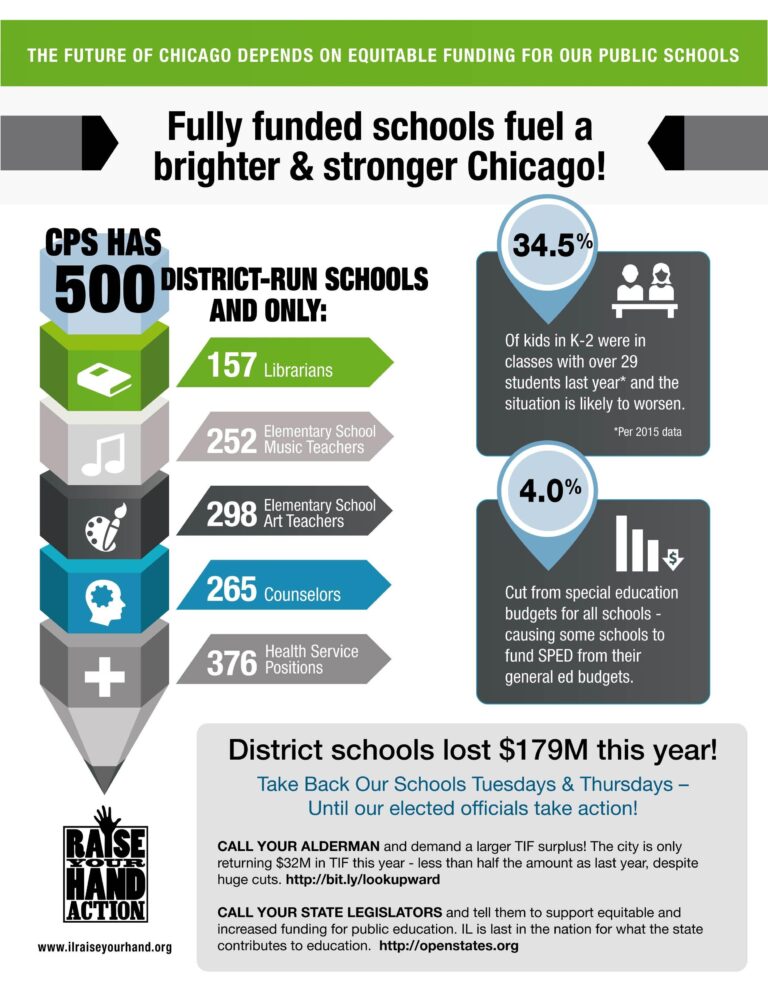Bridging the $1.6 Billion Funding Deficit in Chicago Public Schools: A Critical Imperative
Financial Shortfall Threatens Educational Excellence in Chicago Public Schools
Chicago Public Schools (CPS), serving over 300,000 students, faces a staggering funding shortfall of approximately $1.6 billion from the state, jeopardizing its ability to provide a quality education. This deficit restricts the district’s capacity to enhance classroom materials, attract and keep skilled educators, and modernize aging facilities. The funding gap disproportionately affects students from economically disadvantaged backgrounds, exacerbating existing educational inequities.
The most pressing consequences of this financial strain include:
- Compensation and professional progress for teachers: Insufficient salaries contribute to high turnover and difficulty in recruiting experienced staff.
- Student support infrastructure: Cuts in counseling, special education, and extracurricular activities limit holistic student development.
- Facility upkeep: Deferred maintenance and outdated infrastructure compromise safe and effective learning environments.
| Area | Effect of Funding Deficit |
|---|---|
| Teacher Compensation | Challenges in retention and recruitment |
| Student Services | Reduced counseling and program availability |
| Facilities | Postponed repairs and modernization |
Impact of State Budget Constraints on Resources and Staffing
The persistent budget shortfall has forced CPS to make difficult cuts, affecting both essential resources and personnel. Many schools report shortages in up-to-date textbooks, technology, and access to specialized programs crucial for student achievement. Overcrowded classrooms and stretched support services have become commonplace, undermining educational quality across the district.
Specific repercussions include:
- Teacher layoffs and hiring freezes: Resulting in larger class sizes and fewer specialized educators.
- Reduction in extracurricular and enrichment opportunities: Limiting students’ chances for well-rounded development.
- Decreased mental health and counseling services: Reducing critical support for student well-being.
- Deferred infrastructure maintenance: Compromising safety and learning conditions.
| Resource Type | Consequences |
|---|---|
| Staffing | Elimination of over 2,000 positions |
| Classroom Supplies | 30% budget cuts for materials |
| Student Support | Reduction in mental health personnel |
| Facility Maintenance | Delayed repairs and upgrades |
Unequal Funding Challenges Across Chicago’s Diverse Districts
The $1.6 billion funding gap reflects systemic inequities embedded in CPS’s financial structure. Funding formulas often fail to adequately address the varying needs of districts, especially those with higher concentrations of low-income families, special education students, and English language learners. These disparities manifest in uneven access to resources, technology, and support services.
Analysis reveals:
- Overstretched schools lacking sufficient support staff and infrastructure improvements.
- Unequal distribution of technology and enrichment programs across neighborhoods.
- Higher per-student costs in areas with concentrated poverty and specialized education needs.
| Region | Funding Deficit (in Millions) | Primary Challenges |
|---|---|---|
| South Side | 600 | Resource shortages and high demand for special education |
| West Side | 480 | Facility deterioration and teacher retention struggles |
| North Side | 320 | Limited technology access and curriculum development needs |
Strategic Policy Solutions to Resolve the Education Funding Crisis
Closing the significant funding gap in CPS demands a comprehensive strategy centered on clarity, fairness, and targeted investment. Lawmakers must prioritize increasing state funding by the full $1.6 billion to ensure equitable resource distribution,particularly for historically marginalized communities. Instituting regular financial audits will enhance accountability and public confidence. Additionally,revising funding formulas to reflect inflation and demographic shifts is essential to prevent persistent underfunding.
Investments should extend beyond operational costs to include:
- Dedicated capital for school infrastructure upgrades to foster safe, modern learning spaces.
- Competitive teacher salary enhancements to attract and retain educators, especially in high-need schools.
- Statewide accountability systems linking funding to measurable educational outcomes.
| Policy Initiative | Anticipated Benefit | Priority |
|---|---|---|
| Boost state funding by $1.6 billion | Achieve adequate and equitable funding | High |
| Conduct regular performance audits | Increase fiscal transparency and efficiency | Medium |
| Revise funding formulas for equity | Address disparities in student needs | High |
| Enhance teacher compensation | Improve recruitment and retention | High |
Looking Ahead: Ensuring a Sustainable Future for Chicago’s Students
As Chicago Public Schools confronts this critical funding crisis, the demand for an additional $1.6 billion in state support is a clarion call to rectify entrenched inequities in education financing. Without decisive action, the district risks perpetuating barriers that hinder student achievement and community progress. The decisions made by Illinois legislators in the near term will be instrumental in shaping the trajectory of public education in Chicago, determining whether all students receive the quality education they deserve.








